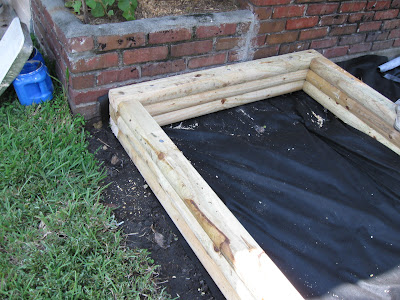The time to clean and prepare the beds for the cool season planting is here. But there are other things still growing in the garden, our summer favorites - sweet potatoes, okra, and cow peas. So it is time to start harvesting sweet potatoes. The harvesting process in itself is fairly simple, just pull the vines (and oh, yes, they can be very long), and then feel the ground with your hands for the tubers. Alternately, you can use a shovel to just turn the soil, but I prefer to use my hands (with the disposable gloves to protect from ant bites). Sweet potatoes do not normally sit deep in the ground, and often you can even see the tip of the potato above the ground. Finally, even if some potatoes are missed and overwinter, the better. I have so many volunteer potatoes in my garden that I don't even plant the slips anymore and always have plenty of sweet potato to harvest; once you have them, you will always have them.

This bowl of potatoes was harvested just from one partial bed, I would say 4 feet by 10 feet, all volunteers. Free food, what can be better! Now I am facing the task of preserving the harvest.
Depending on the amount of sweet potatoes you harvest, no preservation could be needed at all. If you only have a few pounds, then just brush off the dirt, lay them on a cardboard in the sun for a few hours to harden, and you can store them in the pantry. Usually, that's all I do with the harvest.
On the other hand, if you have a large harvest, then it probably would not fit into a regular pantry. Authoritative sources, such as University of Florida, advise to store sweet potatoes in "cool storage" - between 55 to 65 degrees. Well, that's great, but we don't exactly have root cellars in Florida, and the average house garage is far from being "cool" storage, even in the winter. Indigenous people throughout the ages stored sweet potatoes either in sand, or in ash, or in hay. These methods would work even in a hot garage or other storage, but the potatoes themselves should be absolutely perfect, with no nicks or damage; otherwise they will certainly start to rot, and infect their neighbors in the storage bins.
This year I decided to can my sweet potato harvest, and here's why: canning is a sure way to preserve these root vegetables with little risk of spoilage, and the subsequent cooking is practically non-existent, just heat up and eat. I don't care for "sweet" sweet potatoes, such as pies, but like them in a way of
home fries with salt and cayenne. Canned sweet potatoes can be perfect for either scenario.
So, to can sweet potatoes all you need is a pressure canner (I have a cheapo Presto from WalMart), some canning jars and other paraphernalia related to canning. All that can be easily obtained from WalMart or Tractor Supply.
Peel and slice sweet potatoes in about 1/2 to 1/4 inch slices, and put in water. They would turn dark immediately if left in the open air that oxidizes them. As you can see, the water in this basin is quite murky, that's because sweet potatoes have a lot of starch in them:
Once all potatoes are cut up, sterilize canning jars (I use quarts) and stuff raw potato slices into the jars. This is called "raw packing". Shake the jars as you stuff the potatoes to minimize dead space. Add a tea spoon of coarse salt (a preservative), and fill with boiling water. Then, can at 10 pounds pressure for about an hour to an hour and a half.
Pressure canned like that, the potatoes can store for a long time at room temperature, and used whenever you have a hankering for some Thanksgiving-tasting side dish.
You might also be interested in:
Grow sweet potatoes from store bought
Vegetable yields per plant


























































